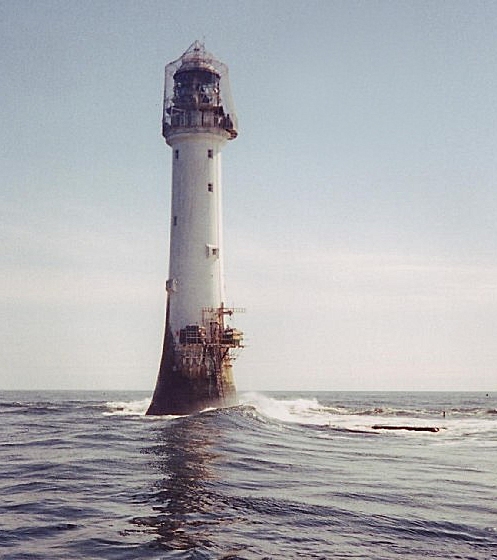There are strange points of resemblance and contrast between him and his distinguished grandson [Robert Louis Stevenson]. The seas and rocks of Scotland were less figured on charts, less lighted and secure you might think, than those South Seas on which the grandson sailed a century later. The romance of the strange and the unknown had its attraction for both generations. The elder Stevenson was no student in his earlier years, but later a continual worker. He was liked and respected, though his hold was that of awe rather than of charm. The most obvious difference was the one was a man of action, the other a man of thought. The one controlled materials and forces, the other ideas. [This passage and those following following come from the author’s Robert Louis Stevenson — George P. Landow]

he great exploit of Robert Stevenson was the building of the Bell Rock tower on what is known in poetry as the Inchcape Rock, with its legend of the bell, and to old-time mariners in fact as a deadly peril. It lies off the mouths of the Tay and Forth, and is about 1400 feet in length, of which 427 are discovered at low water. From 1794 it attracted Stevenson. In December 1799, during a great gale, many ships were cast away on it, chief of them H.M.S. York, which went down with all hands. This quickened public interest and anxiety, but there were long and tedious legislative and other preliminaries to be gone through, and it was not till July 1807 that Robert with a floating lightship and a sloop of 40 tons burden, accompanied by a chosen band of seamen and artificers, attacked the work.

Bell Rock Lighthouse. Wikipedia photograph by Derek Robertson. [Click on image to enlarge it.]
It took four years, for from October to February nothing could be done, and at other times the difticulty was great. It was before the era of steam, and the mechanical appliance of the day seems to us puerile. Forges were built on the Rock, then whenever the tide had sunk, sailors and workers rowed from the ships to the uncovered ground, lighted fires, mined, drilled, scraped with feverish energy for a space of two hours or so, until the tide rose. The workmen toiled up to their knees in water, but presently the furnace hissed in vain against the waves, and all was black. Labour withdrew, carrying many of its implements to the boats, among them the huge bellows which sustained the fire. Not seldom the work was hindered by terrific storms, the lightship tossed so terribly that every minute it threatened to turn turtle, or dash from its moorings on the rock. For twenty-four hours at a time Stevenson never closed an eye or swallowed a morsel of food, yet the ship was no sooner free from danger of wreck, the waves were no sooner reduced to manageable height, than the heroic band, still suffering men- tally and bodily, forced themselves to renewed effort. Again the fire glowed and the chisel rang, the smoke rose to the sky, and at length from the ground there began also to rise the structure of the tower.
In his journal Robert Stevenson recorded the story in minute detail. His grandson was too eminent an artist to spoil the natural force by paraphrase or elaboration, he but pruned and cleared away. It is the most interesting part of the Records of a Family of Engineers, the finest of Stevenson's efforts in biography. The story is full of quaint detail, for here are the men and the manners of another age. The master wished his helpers to labour on Sunday, so he lectured them as to works of necessity and mercy, which the Shorter Catechism allows to break the repose of the Scots Sabbath. His men discussed the point with the unction of an assembly of divines. Yet all were persuaded, save four, whereof three finally gave in. Stevenson records with satisfaction that on that day all toiled with peculiar energy and solemnity.
Once there was a mutiny : the men thought they had not enough beer, and yet the allowance per man was three quarts per diem, with extra draughts on special occasions; also glasses of spirit were doled out when the weather was stormy, or they were early at work or late at work, or when it was the King's birthday, or when anything in fact the least out of the usual happened. One man was sent ashore, whereupon the others submitted. A degenerate race can only wonder at and admire the indomitable courage and persistence of all concerned, the nice scrupulosity of their theological convictions, the seasoned stomachs and seasoned heads, untouched by even the mightiest draughts.
It goes without saying that in every effort and every danger Robert Stevenson was first. No band of men could have accomplished such things without a leader of exceptional force. It is not fanciful to compare those efforts in the face of every physical discouragement with the toil of the grandson who cut and chiselled page after page of word symmetry and beauty through long years of almost mortal sickness; at work again whenever the cruel foe relaxed his grip for a moment.
Related Material
- D. A. Stevenson’s “Robert Stevenson (1772-1850)” -- from The Dictionary of National Biography
Bibliography
Cruse, Amy. Robert Louis Stevenson. George G. Harrap, 1905 Internet Archive version of a copy in the University of Connecticut Library. Web. 9 October 2014.
Last modified 10 October 2014